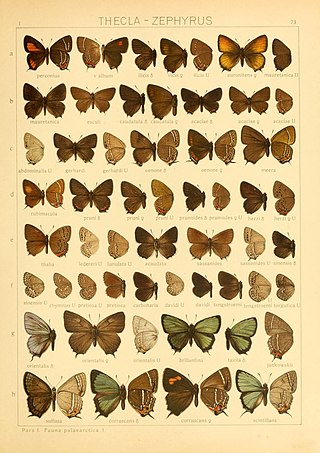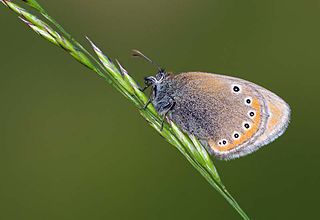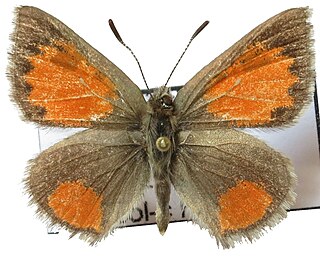
The small heath is a butterfly species belonging to the family Nymphalidae, classified within the subfamily Satyrinae. It is the smallest butterfly in this subfamily. The small heath is diurnal and flies with a noticeable fluttering flight pattern near the ground. It rests with closed wings when not in flight. It is widespread in colonies throughout the grasslands of Eurasia and north-western Africa, preferring drier habitats than other Coenonympha, such as salt marshes, alpine meadows, wetlands, and grasslands near water. However, habitat loss caused by human activities has led to a decline in populations in some locations.

Coenonympha is a butterfly genus belonging to the Coenonymphina, a subtribe of the browns (Satyrinae). The latter are a subfamily of the brush-footed butterflies (Nymphalidae). As a rule, Palearctic species are colloquially called heaths, while Nearctic ones are called ringlets. Neither term is limited to members of this genus, however.

Coenonympha tullia, the large heath or common ringlet, is a butterfly in the family Nymphalidae. It flies in a variety of grassy habitats, including roadsides, woodland edges and clearings, prairies, bogs, and arctic and alpine taiga and tundra. It is a poor flyer, but can sometimes be found along ditches seeking new grounds. It is a holarctic species found in northern Europe, east across the Palearctic and across North America. The species was first described by Otto Friedrich Müller in 1764.

Satyrium ledereri, the orange banded hairstreak, is a butterfly in the family Lycaenidae.

Coenonympha oedippus, the false ringlet, is a species of butterfly in the subfamily Satyrinae. It is found in Austria, Belgium, the Netherlands, France, Hungary, Italy, Japan, Kazakhstan, Liechtenstein, Mongolia, Poland, Russia, Slovakia, Slovenia, Spain, Switzerland, and Ukraine. It is extirpated from Bulgaria, Germany, and Slovakia.

Coenonympha arcania, the pearly heath, is a butterfly species belonging to the family Nymphalidae.

Coenonympha hero, the scarce heath, is a butterfly species belonging to the family Nymphalidae.

Coenonympha nipisiquit, the maritime ringlet, is a rare butterfly in the family Nymphalidae. It is a "species at risk" in Canada due to water pollution and its limited range. Its range is restricted in Canada to the Chaleur Bay region, between New Brunswick and the Gaspé Peninsula.

Coenonympha leander, the Russian heath, is a butterfly belonging to the family Nymphalidae. It is found in northern Greece, Hungary, Bulgaria, southern Russia, Asia Minor, Armenia and Iran. The habitat consists of warm grassy areas.

Lysandra corydonius, the false chalkhill blue, is a butterfly of the family Lycaenidae. The species is distributed in south-eastern Europe, Caucasus, Transcaucasia, north-eastern Turkey, and north-western Iran. L.corydonius is very similar to Lysandra coridon but a slight violet sheen is present, especially in the outer area of the wings. It inhabits a wide variety of grasslands and woodlands. In Armenia it occurs from 1200 to 2000 m above sea level. The known larval host plants of the species in Turkey is Hippocrepis comosa, in the Caucasus - Coronilla varia. The species has not been assessed for the IUCN Red List. In Armenia from 2003 to 2013 its population increased.

Coenonympha symphita, or Lederer's heath, is a butterfly belonging to the family Nymphalidae. It is found in north-eastern Turkey, south-western Georgia, and north-western Armenia.

Tomares callimachus, the Caucasian vernal copper, is a butterfly of the family Lycaenidae. It is found in Anatolia, Iraq, Iran, the Caucasus, and Transcaucasia.
Callophrys paulae, the Pfeiffer's green hairstreak, is a butterfly of the family Lycaenidae. It is found on the Asia Minor, northern Iran, southern Transcaucasia, and the Talysh Mountains.

Coenonympha orientalis is a small butterfly found in the Palearctic that belongs to the browns family. It is found in the Balkans.













